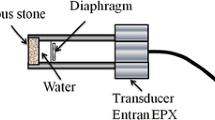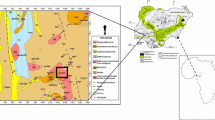Summary
In many parts of the world, particularly in humid tropical regions, residual soils are abundant. In this paper the suitability of a residual lateritic soil as a construction material is investigated, with respect to its strength and compaction characteristics. In comparison with other typical construction fills available in Southeast Asia, compacted lateritic soils produce excellent shear strengths and CBR values. However, the brittleness and tensile cracking of this compacted material become enhanced on the dry side of the optimum moisture content, or if excessive compaction is imparted. Nevertheless, at a moisture content of 2% wetter than the optimum, the tensile mode of failure is suppressed and the lateritic fills become ideally suited for the construction of high embankments and impervious dam cores.
Similar content being viewed by others
References
Ajaz, A. and Parry, R.H.G. (1975) Stress-strain behaviour of two compacted clays in tension and compression,Geotechnique,25 (3), 45–512.
Ajaz, A. (1978) Detection and Prevention of cracking of Clay Cores in Dams, Geotechnical Engineering,J. Southeast Asian Society Soil Engng,9 (1), 39–62.
Bhogal, S.S. and Rankin, W.J. (1987) Geotechnical Aspects of the Surabaya-Malang Project, East Java, Indonesia, Proceedings of the 1987 Asia-Pacific Conference on Roads, Highways and Bridges, Jakarta, Indonesia, pp. 15/1–15/19.
De Graft-Johnson, J.W.S., Bhatia, H.S. and Gidigasu, D.M. (1969) The Engineering Characteristics of the Laterite Gravels of Ghana, Proceedings of the Speciality Session on Engineering Properties of Lateritic Soils, 7th International Conference on Soil Mechanics and Foundation Engineering, Mexico City, Mexico, pp. 117–28.
Dilema, E.L.G. (1990) Development of permeability-floc size criterion for granular filter design, M.Eng. Thesis, No. GT-89-4, Asian Institute of Technology.
Fredlund, D.G., Morgenstern, N.R. and Widger, R.A. (1978) The Shear Strength of Unsaturated Soils,Can. Geotech. J. 15 (3), 313–21.
Gidigasu, M.D. (1976)Laterite Soils Engineering, Elsevier, Amsterdam, p. 554.
Gidigasu, M.D. and Kuma, D.O.K. (1987) Engineering Significance of Lateritization and Profile Development Processes, Proceedings of the 9th Regional Conference in Africa on Soil Mechanics and Foundation Engineering, Lagos, Vol. 1, pp. 3–20.
Hight, D.W., Toll, D.G. and Grace, H. (1988) Naturally Occurring Gravels for Road Construction, Proceedings of the 2nd International Conference on Geomechanics in Tropical Soils, Singapore, pp. 405–12.
Indraratna, B., Dilema, E.L.G. and Nutalaya, P. (1990) Design of Granular Filters for a Residual Lateritic Soil,J. Dam Engng, International Water Power & Dam Construction,1 (3), pp. 201–20.
Krishnayya, A.V.G., Eisenstein, Z. and Morgenstern, N.R. (1974) Behaviour of Compacted Soil in Tension, Journal of Geotechnical Engineering DivisionProc. ASCE,100, GT-9, pp. 1051–61.
Leonards, G.A. and Narain, J. (1963) Flexibility of Clay and Cracking of Earth Dams, Journal of Soil Mechanics Foundation Division,Proc. ASCE,89, SM-2, pp. 47–98.
Little, A.L. (1967) The Use of Tropically Weathered Soils in the Construction of Earth Dams, Third Asian Regional Conference on Soil Mechanics and Foundations Engineering, Haifa, Vol. 1, pp. 35–41.
Little, A.L. (1975)In situ diaphragm walls for embankment dams; diaphragm walls and anchorages, Institution of Civil Engineers, London, pp. 23–6.
Malaysian Highway Authority (1989) Proceedings of the International Symposium on Trial Embankments on Malaysian Marine Clays, Kuala Lumpur.
Matyas, E.L. (1969) Some Engineering Properties of Sasumua Clay, Proceedings of the 7th International Conference on Soil Mechanics & Foundation Engineering, Mexico City, Mexico, pp. 143–51.
Mazhar, M.F. (1969) Methods of preparation of index properties of lateritic soils, M.Eng. Thesis, Asian Institute of Technology, Bangkok, Thailand.
McFarlane, M.J. (1976)Laterite and landscape, Academic Press, London.
Ogunsanwo, O. (1989) CBR and Shear Strengths of Compacted Laterite Soils from Southwestern Nigeria,Quart. J. Engng. Geology, Lond. 22, 317–28.
Sherard, J.L., Woodward, R.J., Gizienski, S.F. and Clevenger, W.A. (1963)Earth and Earth-Rock Dams, Engineering Problems of Design Construction, John Wiley and Sons, New York.
Terzaghi, K. (1958) Design and Performance of the Sasumua Dam,Proc. Inst. Civil Engineers, Lond. 9, 369–94.
Toll, D.G. (1990) A framework for unsaturated soil behaviour,Geotechnique 40 (1), 31–44.
Author information
Authors and Affiliations
Rights and permissions
About this article
Cite this article
Indraratna, B., Nutalaya, P. Some engineering characteristics of a compacted lateritic residual soil. Geotech Geol Eng 9, 125–137 (1991). https://doi.org/10.1007/BF00881254
Received:
Issue Date:
DOI: https://doi.org/10.1007/BF00881254




